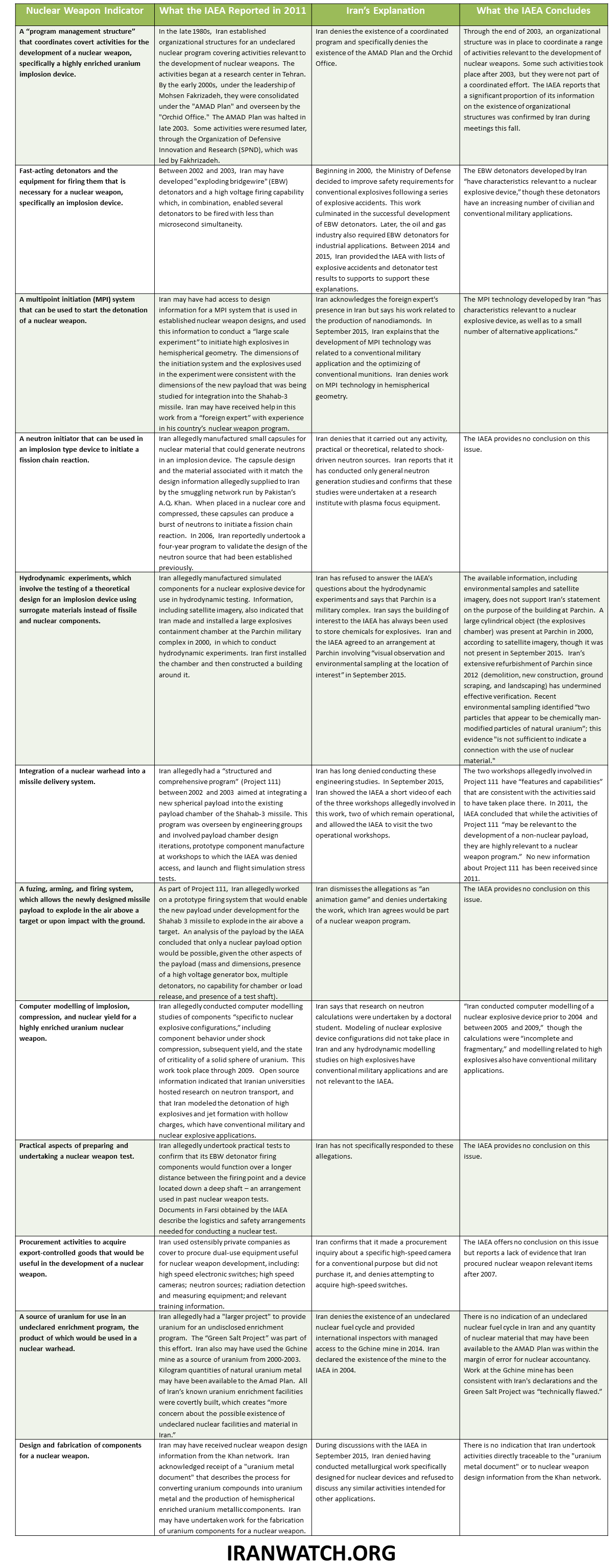 The International Atomic Energy Agency (IAEA) released its long-awaited final report on Iran’s alleged past nuclear weapons work on December 2. This report is likely to be the Agency’s last word on its investigation into what it calls “the possible military dimensions [PMD] to Iran’s nuclear program.” The Agency found that Iran had a “coordinated” program to develop a nuclear weapon through the end of 2003 and that some of the work on nuclear weapons continued into 2009. Specifically, the IAEA found that Iran developed several components of a nuclear weapon and undertook related research and testing.
The International Atomic Energy Agency (IAEA) released its long-awaited final report on Iran’s alleged past nuclear weapons work on December 2. This report is likely to be the Agency’s last word on its investigation into what it calls “the possible military dimensions [PMD] to Iran’s nuclear program.” The Agency found that Iran had a “coordinated” program to develop a nuclear weapon through the end of 2003 and that some of the work on nuclear weapons continued into 2009. Specifically, the IAEA found that Iran developed several components of a nuclear weapon and undertook related research and testing.
This report is part of a side agreement between the IAEA and Iran. The IAEA’s conclusions are not directly linked to the implementation of the larger nuclear deal with Iran, which may explain the limited nature of Iran’s cooperation. To many of the Agency’s questions, Iran offered no new information, or made denials without explanation, or gave explanations contradicted by other information available to the Agency. The report sheds little new light on the allegations originally compiled by the Agency in 2011 and leaves unanswered many questions about the extent of both Iran’s nuclear capability and its intentions.
Nevertheless, the countries of the P5+1 appear willing to accept the IAEA’s incomplete report and close the book on the PMD issue. According to U.S. State Department spokesperson Mark Toner, the P5+1 will introduce a resolution at the next IAEA Board of Governors meeting on December 15 to bring the PMD investigation to an end. Iran, for its part, has stated that it will not implement the nuclear agreement, known as the Joint Comprehensive Plan of Action (JCPOA), until the IAEA investigation is concluded. In a November 29 interview, Iran’s former defense minister and current secretary of the Supreme National Security Council warned that “without the closure of the file regarding past issues, there is no possibility of implementing the JCPOA.”
The allegations about a nuclear weapons program in Iran began surfacing in 2002, and the IAEA consolidated the “outstanding issues related to possible military dimensions to Iran’s nuclear program” in a report issued in November 2011. The analysis in the report was based on information that the Agency received from IAEA member states, from the Agency’s own investigative efforts, and from information provided by Iran. The IAEA judged the allegations of work on nuclear weapons “to be, overall, credible” and “consistent in terms of technical content, individuals and organizations involved, and time frames.” In a 2012 resolution, the IAEA Board of Governors decided that “the resolution of all outstanding issues was essential and urgent in order to restore international confidence in the exclusively peaceful nature of Iran’s nuclear program.”
The 2011 IAEA report described detailed information about Iran’s efforts to develop a nuclear weapon, including:
- computer modeling of implosion, compression, and nuclear yield, as recently as 2009;
- high explosive tests simulating a nuclear explosion but using non-nuclear material in order to see whether an implosion device would work;
- the construction of at least one containment vessel at a military site, in which to conduct such high explosive tests;
- studies on detonation of high explosive charges, in order to ensure uniform compression in an implosion device, including at least one large scale experiment in 2003, and experimental research after 2003;
- support from a foreign expert, reportedly a former Soviet weapon scientist named Vyacheslav Danilenko, in developing a detonation system suitable for nuclear weapons and a diagnostic system needed to monitor the detonation experiments;
- manufacture of a neutron initiator, which is placed in the core of an implosion device and, when compressed, generates neutrons to start a nuclear chain reaction, along with validation studies on the initiator design from 2006 onward;
- the development of exploding bridgewire detonators (EBWs) used in simultaneous detonation, which are needed to initiate an implosive shock wave in fission bombs;
- the development of high voltage firing equipment that would enable detonation in the air, above a target, in a fashion only making sense for a nuclear payload;
- testing of high voltage firing equipment to ensure that it could fire EBWs over the long distance needed for nuclear weapon testing, when a device might be located down a deep shaft;
- a program to integrate a new spherical payload onto Iran’s Shahab-3 missile, enabling the missile to accommodate the detonation package described above.
The chart below details each of the 12 “outstanding issues” identified by the IAEA, and it explains their significance for nuclear weapons. It also lists the original evidence or basis for concern described by the IAEA in 2011, as well as any explanation offered by Iran since then. It ends with the IAEA’s conclusion. For most of the 12 issues, the IAEA, in the absence of new information or meaningful disclosures from Iran, has merely reiterated the evidence contained in its 2011 report. This “final” report fails to present a complete picture of Iran’s past work on nuclear weapons.
[Click here for a larger version of the chart.]


